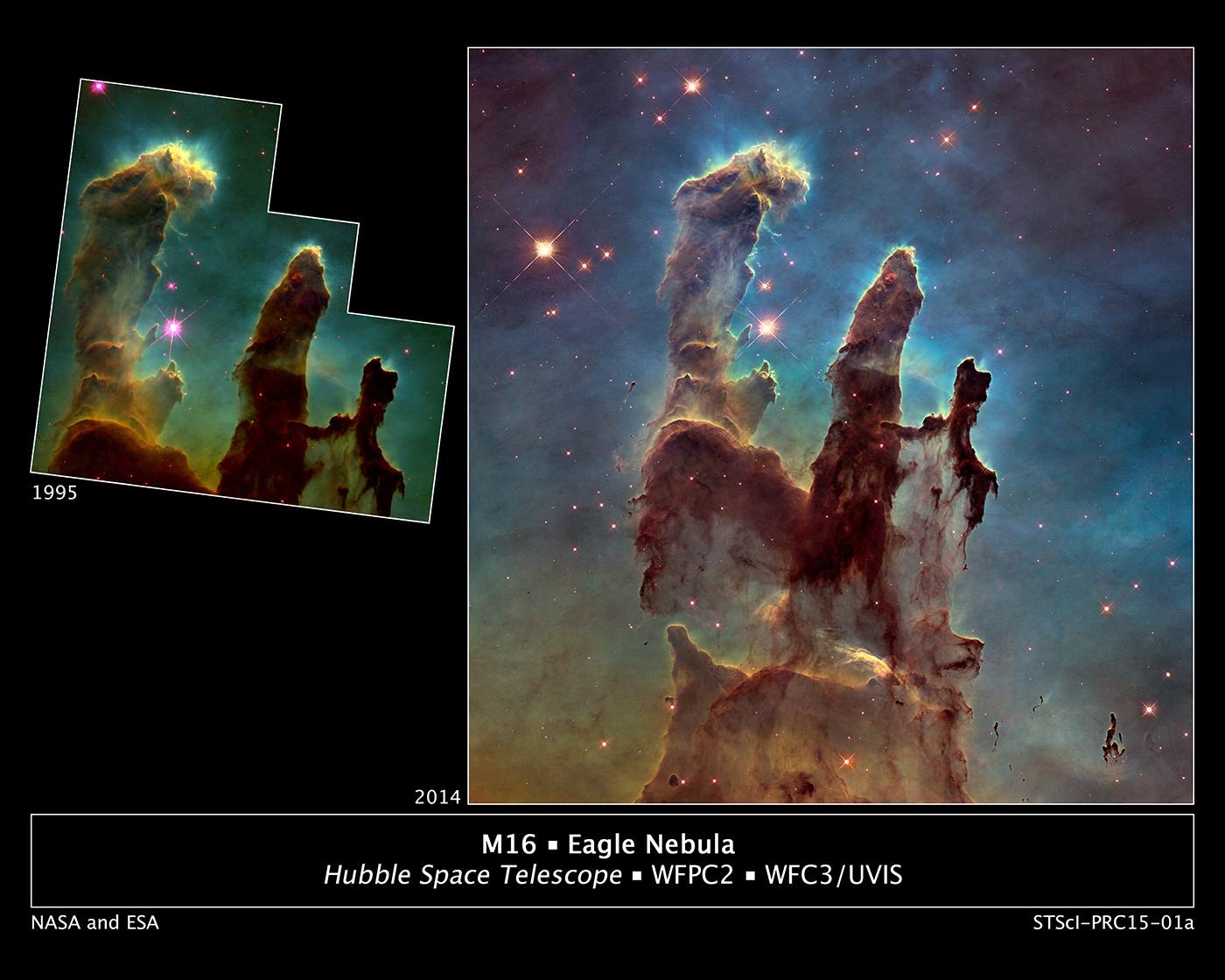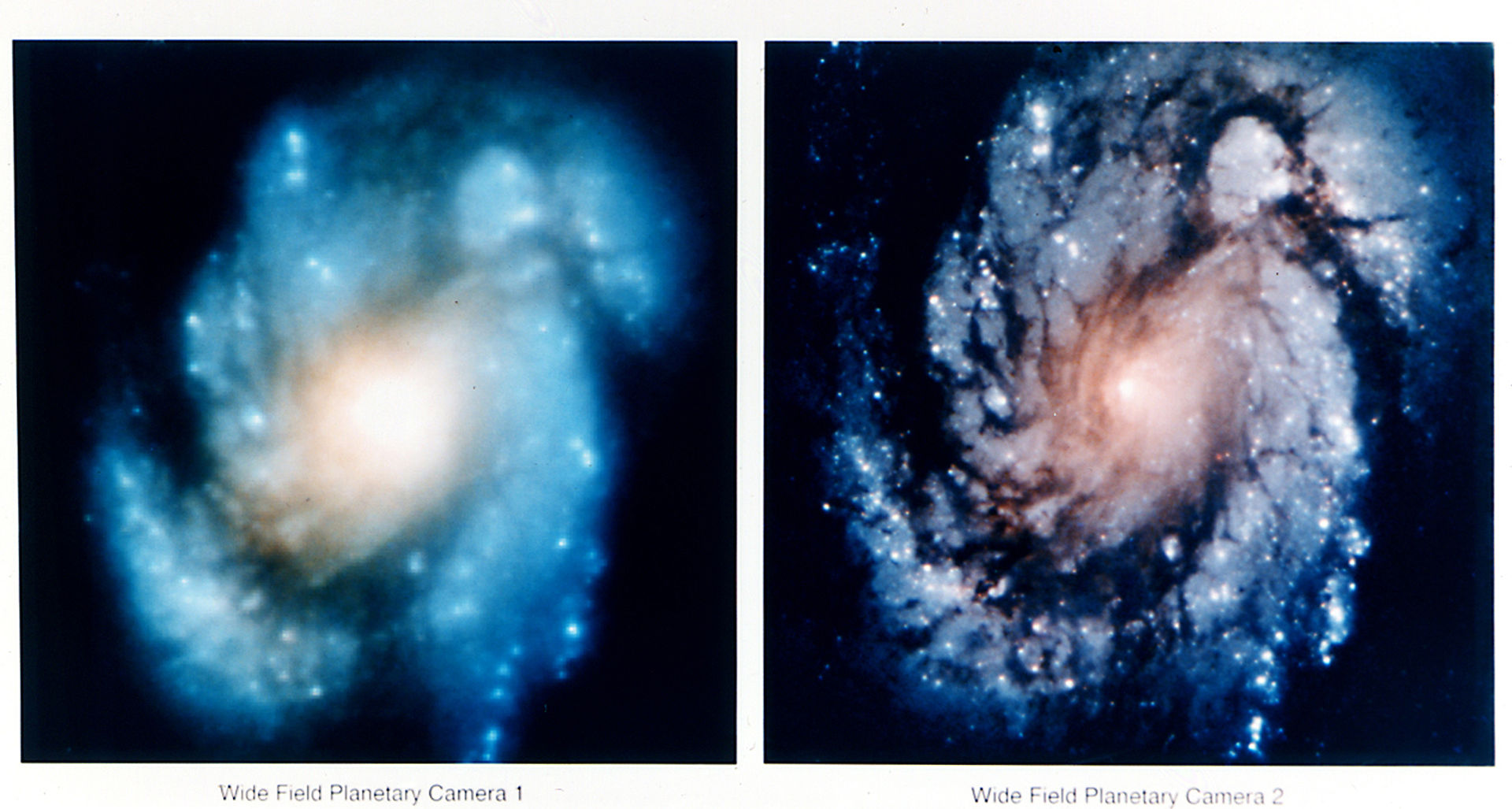The following is a NASA announcement, written by Felicia Chou and Ray Villard and posted January 5, 2015 with the title above:
Although NASA’s Hubble Space Telescope has taken many breathtaking images of the universe, one snapshot stands out from the rest: the iconic view of the so-called “Pillars of Creation.” The jaw-dropping photo, taken in 1995, revealed never-before-seen details of three giant columns of cold gas bathed in the scorching ultraviolet light from a cluster of young, massive stars in a small region of the Eagle Nebula, or M16.
Though such butte-like features are common in star-forming regions, the M16 structures are by far the most photogenic and evocative. The Hubble image is so popular that it has appeared in movies and television shows, on T-shirts and pillows, and even on a postage stamp.
And now, in celebration of its upcoming 25th anniversary in April, Hubble has revisited the famous pillars, providing astronomers with a sharper and wider view. As a bonus, the pillars have been photographed in near-infrared light, as well as visible light. The infrared view transforms the pillars into eerie, wispy silhouettes seen against a background of myriad stars. That’s because the infrared light penetrates much of the gas and dust, except for the densest regions of the pillars. Newborn stars can be seen hidden away inside the pillars. The new images are being unveiled at the American Astronomical Society meeting in Seattle.
Although the original image was dubbed the Pillars of Creation, the new image hints that they are also pillars of destruction. “I’m impressed by how transitory these structures are. They are actively being ablated away before our very eyes. The ghostly bluish haze around the dense edges of the pillars is material getting heated up and evaporating away into space. We have caught these pillars at a very unique and short-lived moment in their evolution,” explained Paul Scowen of Arizona State University in Tempe. He and astronomer Jeff Hester, formerly of Arizona State University, led the original Hubble observations of the Eagle Nebula.
The infrared image shows that the very ends of the pillars are dense knots of dust and gas. They shadow the gas below them, keeping the gas cool and creating the long, column-like structures. The material in between the pillars has long since been evaporated away by the ionizing radiation from the central star cluster located above the pillars.
At the top edge of the left-hand pillar, a gaseous fragment has been heated up and is flying away from the structure, underscoring the violent nature of star-forming regions. “These pillars represent a very dynamic, active process,” Scowen said. “The gas is not being passively heated up and gently wafting away into space. The gaseous pillars are actually getting ionized, a process by which electrons are stripped off of atoms, and heated up by radiation from the massive stars. And then they are being eroded by the stars’ strong winds and barrage of charged particles, which are literally sandblasting away the tops of these pillars.”
When Scowen and Hester used Hubble to make the initial observations of the Eagle Nebula in 1995, astronomers had seen the pillar-like structures in ground-based images, but not in detail. They knew that the physical processes are not unique to the Eagle Nebula because star birth takes place across the universe. But at a distance of just 6,500 light-years, M16 is the most dramatic nearby example – as the team soon realized.
As Scowen was piecing together the Hubble exposures of the Eagle, he was amazed at what he saw. “I called Jeff Hester on his phone and said, ‘You need to get here now,’” Scowen recalled. “We laid the pictures out on the table, and we were just gushing because of all the incredible detail that we were seeing for the very first time.”
The first features that jumped out at the team in 1995 were the streamers of gas seemingly floating away from the columns. Astronomers had previously debated what effect nearby massive stars would have on the surrounding gas in stellar nurseries. “There is the only one thing that can light up a neighborhood like this: massive stars kicking out enough horsepower in ultraviolet light to ionize the gas clouds and make them glow,” Scowen said. “Nebulous star-forming regions like M16 are the interstellar neon signs that say, ‘We just made a bunch of massive stars here.’ This was the first time we had directly seen observational evidence that the erosionary process, not only the radiation but the mechanical stripping away of the gas from the columns, was actually being seen.”
By comparing the 1995 and 2014 pictures, astronomers also noticed a lengthening of a narrow jet-like feature that may have been ejected from a newly forming star. The jet looks like a stream of water from a garden hose. Over the intervening 19 years, this jet has stretched farther into space, across an additional 60 billion miles, at an estimated speed of about 450,000 miles per hour.
Our sun probably formed in a similar turbulent star-forming region. There is evidence that the forming solar system was seasoned with radioactive shrapnel from a nearby supernova. That means that our sun was formed as part of a cluster that included stars massive enough to produce powerful ionizing radiation, such as is seen in the Eagle Nebula. “That’s the only way the nebula from which the sun was born could have been exposed to a supernova that quickly, in the short period of time that represents, because supernovae only come from massive stars, and those stars only live a few tens of millions of years,” Scowen explained. “What that means is when you look at the environment of the Eagle Nebula or other star-forming regions, you’re looking at exactly the kind of nascent environment that our sun formed in.”
The Hubble Space Telescope is a project of international cooperation between NASA and the European Space Agency. NASA’s Goddard Space Flight Center in Greenbelt, Maryland, manages the telescope. The Space Telescope Science Institute (STScI) in Baltimore conducts Hubble science operations. STScI is operated for NASA by the Association of Universities for Research in Astronomy, Inc., in Washington.
NASA is exploring our solar system and beyond to understand the universe and our place in it. We seek to unravel the secrets of our universe, its origins and evolution, and search for life among the stars. Today’s announcement shares the discovery of our ever-changing cosmos, and brings us closer to learning whether we are alone in the universe.
 Astronomers using NASA’s Hubble Space Telescope have assembled a bigger and sharper photograph of the iconic Eagle Nebula’s “Pillars of Creation” (right); the original 1995 Hubble image is shown at left. Credit: NASA/ESA/Hubble Heritage Team (STScI/AURA)/J. Hester, P. Scowen (Arizona State U.). Photo source: the NASA announcement.
Astronomers using NASA’s Hubble Space Telescope have assembled a bigger and sharper photograph of the iconic Eagle Nebula’s “Pillars of Creation” (right); the original 1995 Hubble image is shown at left. Credit: NASA/ESA/Hubble Heritage Team (STScI/AURA)/J. Hester, P. Scowen (Arizona State U.). Photo source: the NASA announcement.  The Hubble Space Telescope as seen from the departing Space Shuttle Atlantis, flying Servicing Mission 4 (STS-125), the fifth and final human spaceflight to it. Hubble is the only telescope designed to be serviced in space by astronauts. After launch by Space Shuttle Discovery in 1990, four subsequent Space Shuttle missions repaired, upgraded, and replaced systems on the telescope. A fifth mission was canceled on safety grounds following the Columbia disaster. However, after spirited public discussion, NASA administrator Mike Griffin approved one final servicing mission, completed in 2009. The telescope is still operating as of 2015, and may last until 2020. Its scientific successor, the James Webb Space Telescope (JWST), is scheduled for launch in 2018 (Wikipedia: Hubble Space Telescope)
The Hubble Space Telescope as seen from the departing Space Shuttle Atlantis, flying Servicing Mission 4 (STS-125), the fifth and final human spaceflight to it. Hubble is the only telescope designed to be serviced in space by astronauts. After launch by Space Shuttle Discovery in 1990, four subsequent Space Shuttle missions repaired, upgraded, and replaced systems on the telescope. A fifth mission was canceled on safety grounds following the Columbia disaster. However, after spirited public discussion, NASA administrator Mike Griffin approved one final servicing mission, completed in 2009. The telescope is still operating as of 2015, and may last until 2020. Its scientific successor, the James Webb Space Telescope (JWST), is scheduled for launch in 2018 (Wikipedia: Hubble Space Telescope)



